Journal Club: Sing for your supper: fairy-wren chicks must sing vocal password for food
SUMMARY: Female fairy-wrens teach their chicks a vocal password before they hatch to distinguish them from brood parasitic bronze-cuckoo chicks
 How do parents recognize their offspring when the cost of making an error is high? To avoid wasting valuable time and energy by raising chicks of another species that commonly sneaks eggs into its nest, female superb fairy-wrens make a signature call whilst incubating their eggs, thereby teaching her chicks her unique “vocal password” whilst they are still inside their eggs. These females also share this password with their mates and any nest helpers by singing it to them in a “solicitation song” performed away from the nest. As a result, only her chicks make this vocal password after hatching, allowing only the parents to identify their offspring simply by listening to them. The parents thus distinguish their chicks from brood parasitic bronze-cuckoo chicks, which do not learn this call.
How do parents recognize their offspring when the cost of making an error is high? To avoid wasting valuable time and energy by raising chicks of another species that commonly sneaks eggs into its nest, female superb fairy-wrens make a signature call whilst incubating their eggs, thereby teaching her chicks her unique “vocal password” whilst they are still inside their eggs. These females also share this password with their mates and any nest helpers by singing it to them in a “solicitation song” performed away from the nest. As a result, only her chicks make this vocal password after hatching, allowing only the parents to identify their offspring simply by listening to them. The parents thus distinguish their chicks from brood parasitic bronze-cuckoo chicks, which do not learn this call.
Superb fairy-wrens, Malurus cyaneus, are common and colourful birds that live in the relatively moist and fertile southeastern corner of Australia. These songbirds are so small that an entire family could fit on the palm of your hand — if they would only sit still! Restless and active, these birds forage mainly on insects although they will take some seed as well.
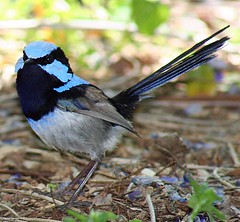 Superb fairy-wrens are strongly sexually dimorphic and show a number of unusual and interesting breeding behaviours. For example, the brilliantly-coloured males (pictured, right) have a courtship ritual that includes displaying yellow flower petals they’ve plucked to impress females. Although superb fairy-wrens are socially monogamous, they are sexually promiscuous, so each member of the pair will mate with other individuals and remarkably, males often help raise their extra-pair offspring.
Superb fairy-wrens are strongly sexually dimorphic and show a number of unusual and interesting breeding behaviours. For example, the brilliantly-coloured males (pictured, right) have a courtship ritual that includes displaying yellow flower petals they’ve plucked to impress females. Although superb fairy-wrens are socially monogamous, they are sexually promiscuous, so each member of the pair will mate with other individuals and remarkably, males often help raise their extra-pair offspring.
Superb fairy-wrens build their nest near the ground in thick vegetation. Consisting of loosely woven grasses and spider webs, this round or domed structure has a small side entrance. Because the interior of their nests is quite dark, fairy-wrens readily accept and incubate the eggs of other species. This is, of course, the perfect set-up for brood parasitism — birds of other species that sneak their own eggs into fairy-wrens nests for them to incubate and care for.
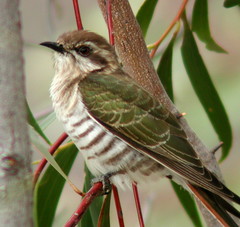 Superb fairy-wrens’ nests are parasitised by several cuckoo species; their most common brood parasite being Horsfield’s bronze-cuckoo, Chrysococcyx (Chalcites) basalis (pictured, right). Although fairy-wrens incubate bronze-cuckoo eggs, they can identify whether their brood includes cuckoo chicks after the eggs have hatched. How do they do it?
Superb fairy-wrens’ nests are parasitised by several cuckoo species; their most common brood parasite being Horsfield’s bronze-cuckoo, Chrysococcyx (Chalcites) basalis (pictured, right). Although fairy-wrens incubate bronze-cuckoo eggs, they can identify whether their brood includes cuckoo chicks after the eggs have hatched. How do they do it?
“Fairy-wrens were known to discriminate against cuckoo nestlings on the basis of their foreign begging calls”, said Sonia Kleindorfer, a Professor of Animal Behaviour and Ecology at Flinders University in Adelaide and Scientific Director at the Flinders Research Centre for Climate Adaptation and Animal Behaviour, who led these studies.
“Parents and others attending the nestlings will only feed them if their begging calls contain the learned password,” explained Professor Kleindorfer. If the chicks don’t sing the correct password, the parents abandon the nest and start again.
This serendipitous discovery came when Professor Kleindorfer and her team noticed something odd when analysing audiovisual recordings of nesting superb fairy-wrens for a different study: fairy-wrens chicks’ begging calls varied from one nest to another (sonogram of begging chicks or view larger).

Superb fairy-wren chick begging calls do not sound the same from one nest to the next.
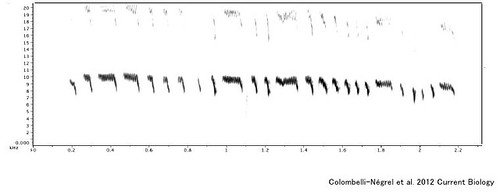
Adult female superb fairy wrens’ “incubation calls” contain unique signature elements that their chicks produce after hatching.
The researchers found that incubating females produced an average of 16 of these calls per hour late in the incubation period, 4 to 5 days prior to hatching, ceasing this call shortly before hatching (blue arrow, figure 1 or view larger):
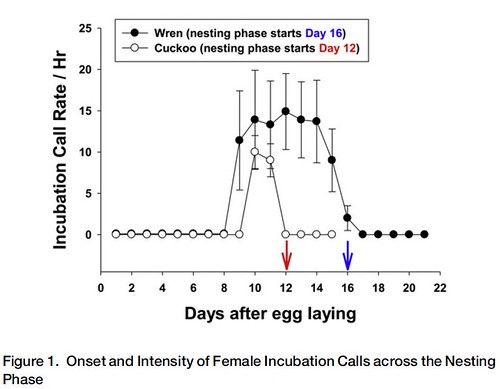

Not only was the signature element in each female’s incubation call significantly more similar to the begging call produced by their own nestlings, but it was not similar to begging calls recorded from any other fairy-wren brood. This led the researchers to ask whether this familial similarity in calls was the result of shared genes or shared experiences? Were the nestlings born “knowing” their password begging calls or did they learn their calls from their mothers? Do the mother’s incubation calls help the chicks fine-tune their own begging calls whilst they are still embryos?
To address this question, the researchers cross-fostered eggs from one nest to another and recorded and compared the foster mother’s incubation calls to the begging calls of her fostered nestlings (figure 2 or view larger):
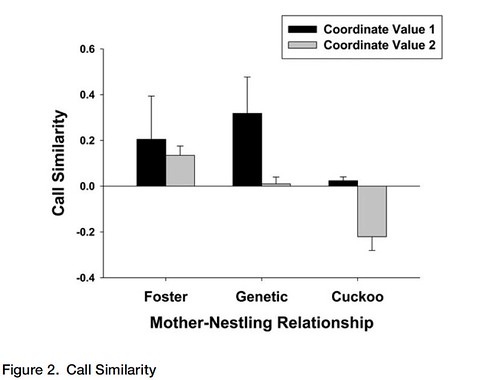

The researchers found that females did not recognize the begging calls made by their own genetic offspring when their chicks had been raised by a foster hen, and the genetic mothers behaved as if hearing unfamiliar nestlings (data not shown). Further, fairy-wren parents stopped feeding their nestlings when researchers placed a loudspeaker under their nest that played the wrong begging calls.
Equally important; bronze-cuckoo chicks clearly did not learn their foster mother’s calls. But why?
To answer that question, let’s review the findings so far: fairy-wren eggs hatch after 15 days of incubation; so the nestlings in a non-parasitized nest are exposed as embryos to their mother’s incubation call for 5 days (figure 3A or view larger, also see figure 1, blue arrow):

Figure 3. Hypothetical Timeline for Incubation and Begging Calls: schematic timeline for onset of the incubation call by the female wren, onset of the nestling begging call, and outcome of call similarity in nests not parasitized by cuckoos (A) and in nests parasitized by cuckoos (B).
Professor Kleindorfer and her colleagues hypothesise that perhaps the fairy-wren nestlings’ call similarity is influenced by their cumulative long-term exposure to the female’s incubation call, an experience that the bronze-cuckoo nestling cuts short. If this is the case, perhaps the next evolutionary step in this acoustical arms race will be for bronze-cuckoos to fine-tune their embryos’ development so they become capable of learning the fairy-wrens’ vocal password in a shorter time-frame? Only time will tell.
These findings demonstrate that traits that appear to be innate, such as nestling begging calls, may actually be learned. Knowing this adds to our understanding of evolution and also has many practical implications, particularly for captive breeding and conservation biology.
“We show that females that guard and teach the embryo could increase the transmission efficacy of female cultural traits,” explained Professor Kleindorfer in a press release.
“In systems with uniparental care, caretakers of embryos will have more opportunity to pass on female memes, or ‘messages,’ to the embryo.” Thus, mothers have a special ability to transmit not just genes to the next generation, but also memes.
Sources:
Colombelli-Négrel D., Hauber M., Robertson J., Sulloway F., Hoi H., Griggio M. & Kleindorfer S. (2012). Embryonic Learning of Vocal Passwords in Superb Fairy-Wrens Reveals Intruder Cuckoo Nestlings. Current Biology, 22 (22) DOI: 10.1016/j.cub.2012.09.025
Sonia Kleindorfer; emails: 9 November 2012
see also:
Langmore N.E., Hunt S. & Kilner R.M. (2003). Escalation of a coevolutionary arms race through host rejection of brood parasitic young. Nature, 422 (6928) 157-160. DOI: 10.1038/nature01460
Many thanks to my twitter pals, Elspeth Kenny, L Gerrard, Thomas White, Steven Byrnes, Adam Wollman, Kriszta Vályi and Lindsay Napier for quickly retrieving these PDFs and emailing them to me.
NOTE: slightly edited from the original, which was published on The Guardian.
.. .. .. .. .. .. .. .. .. .. ..
Follow Grrlscientist’s work on facebook, Google +, LinkedIn, Pinterest and of course, twitter: @GrrlScientist
email: grrlscientist@gmail.com
